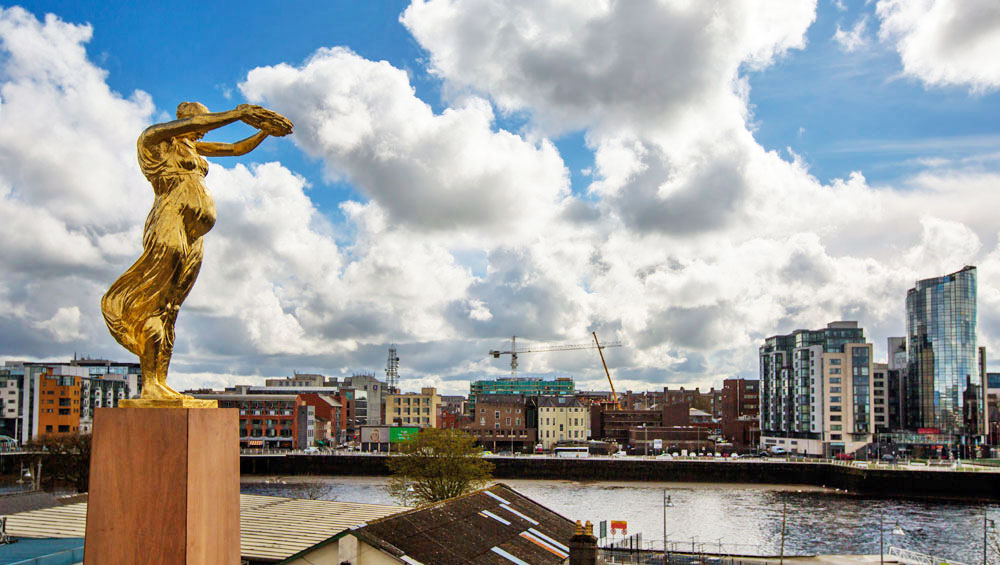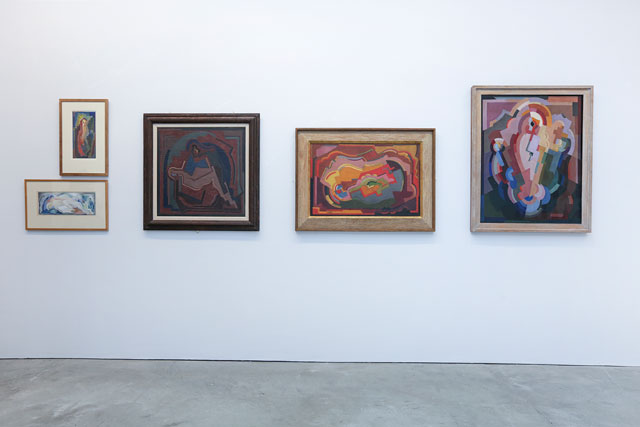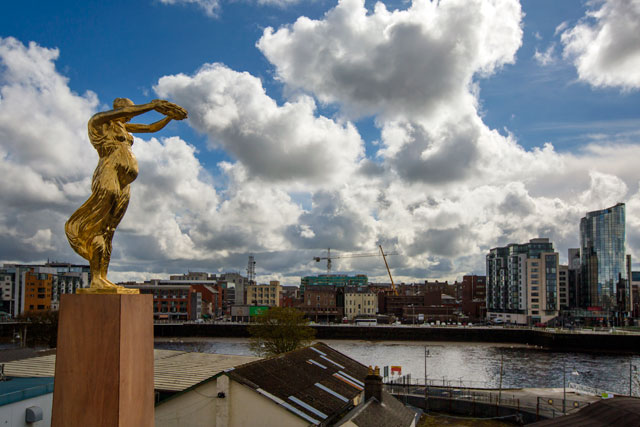
by HATTY NESTOR
Inti Guerrero is the man behind this year’s curatorial vision of EVA International, Ireland’s biennial. On 14 April, 12 weeks of events began in Limerick for this year’s event, which seeks to explore questions of identity and politics and includes 56 international artists working in a wide range of mediums and forms. Guerrero, who was born in Bogotá, Colombia, in 1983, is currently Estrellita B Brodsky adjunct curator of Latin American Art at Tate London. For this 38th EVA International, he has drawn inspiration from Irish artist Seán Keating’s painting Night’s Candles Are Burnt Out (1927). The painting presents an allegory of the Irish psyche at the start of the construction that year of Ardnacrusha, a hydroelectric power station that led to the rapid industrialisation of Ireland. Against the backdrop of the construction site, with a businessman in a suit and hat centre stage, are a group of characters, whose lives are set to change in a new era of technological progress.
Since its foundation in 1977, EVA International has worked with 2,041 artists and 41 curators. Over the years, the biennial has exhibited work from Paul O’Keefe in 1984 to Thelma Chambers (for 1990 for the Climate of Thought edition) and Amanda Beech in 2014, and in 2016 the biennial was curated by Koyo Kouoh.
As part of the 2018 opening public programme, several events will confront current sociopolitical issues in Ireland, in particular the law on abortion and the effect it has on women. Many of the artists in the biennial deal with the issue in anticipation of the referendum taking place in May on whether the eighth amendment – giving a foetus and the woman carrying it equal rights – should be repealed. One such work is Not At Home – a performance by Grace Dyas as part of the biennial’s collaborative public programme with Ormston House – which exposes the struggles of Irish women who, as a consequence of the country’s abortion laws, have been forced to travel abroad to access safe and legal abortions. With these weighted political concerns of abortion and heritage, the biennial promises to pose wider questions of the current situation in Ireland through art.
Hatty Nestor: Alongside curating EVA International, you are also the adjunct curator of Latin American Art at Tate London. You studied history and theory of art and architecture in Colombia and Brazil, later doing a curatorial programme at De Appel arts centre in Amsterdam. How did these educational experiences influence your current work?
Inti Guerrero: During the process of making EVA, people asked me if there would be a “Latin American” focus at the biennial. Although I have generally researched the work of artists coming from the Americas, I’ve been more inclined to connect their practices within a wider transnational and intergenerational dialogue – in other words, trying not to fall into the cultural production and consumption of difference that occurs with spectatorship, especially in Europe and the US.
In terms of “influence”, my years in college in Brazil have definitely had an important impact while thinking through various exhibitions. In previous and current projects, the legacies and thought around 20th-century modern architecture always seems to surface in some way or another. At EVA, for example, the work Brasilia Hall (2001), by French artist Dominique Gonzalez-Foerster (b1965), is one of the central pieces of the show. The work is a large empty space covered with green carpet, simulating a long field, an architectural landscape, where at one end of a large empty white wall there is a red neon sign that says “Brasilia Hall” and, at the other end of this very long space/hall, a flickering light comes from a small screen embedded on the wall, in which archival footage of the construction of Brasilia is being shown. Between 1957 and 1960, Brazil’s capital, Brasilia, was built in the country’s emblematic functionalist architecture, marking a new modernisation of the nation-state. Seen today, the empty vacuum space in Gonzalez-Foerster’s piece is an invitation to create horizons for political imagination – to bring back visionary utopian thinking, especially in our current moment of vulnerable democracies all across the globe, including the shockwaves following Brexit and the presidential election in the US.
.jpg)
Rita Duffy. Siege II, 1989. Oil on gesso panel, 122.25 × 122 cm. Courtesy of The Model Home of the Niland Collection/ Graeve Collection.
HN: As the curator of the biennial, you have overseen and selected the creative work of 56 artists. Can you talk about your vision behind Eva International, and its relation to the current political climate?
IG: After having carried out research trips to Northern Ireland (Derry and Belfast), it became evident that the work by artists made in the years preceding the 1998 Good Friday Agreement seemed extremely relevant in today’s new political turmoil – ignited by Brexit and the possibility of a new hard border, a new border not only with the Republic, but with Europe. An important presence of works by the figurative painter Rita Duffy and the experimental sculptor Locky Morris, both from the early 90s, have been included in the exhibition.
.-Photograph,-100-x-120-cm.-Courtesy-the-artist-and-EVA-International.jpg)
John Duncan. Glenbryn Park, Belfast 2004 (2008). Photograph, 100 x 120 cm. Courtesy the artist and EVA International.
The subject of their work reverberates in the anthropological lens of John Duncan (b1968), who in recent years has been photographing the uncanny normality of the Eleventh Night in Northern Ireland, an annual celebration in which Ulster Protestant loyalists burn bonfires with Irish flags in an open display of anti-Catholic and anti-republican sentiment. All of these artists from the North are found in separate constellations of artworks across EVA. In other words, there isn’t a room on these troubles, but each one of them anchors a different relationship between works from other contexts, presenting wider forms and debates on hatred and xenophobia, for example.
HN: The Artists’ Campaign to Repeal the Eighth Amendment, which originated from conversations in 2015, draws attention to how this amendment has affected women politically. A large part of the programme focuses on the forthcoming abortion referendum. Curatorially, did it feel urgent to discuss these issues?
IG: Yes, it definitely did. In fact, to connect it a little bit to the work of Gonzalez-Foerster, one may see the role of the artist in this civil rights activism on abortion rights as the primary political horizon and imagination in Ireland today. The referendum on whether the 1983 eighth amendment to Ireland’s constitution should be repealed will take place during the 38th EVA International. The eighth amendment is a religious and patriarchal law that continues to criminalise abortion, giving equal rights to life to both the mother and the foetus, making Ireland one of the very few states in Europe where abortion is illegal. The inclusion of the Artists’ Campaign to Repeal the Eighth Amendment is, therefore, a crucial part of the exhibition. At the opening, the campaign organised a very strong and effective procession with banners and live acts. On view in the exhibition space, audiences will also have the chance to see documentation of previous acts of protest by the Artists’ Campaign, and a curated short film programme focused on the trauma of many Irish women having to travel to the UK and Europe to get an abortion.

Mainie Jellett. Installation view at the 38th EVA International 2018. Photograph: Deirdre Power, courtesy of the artist, EVA International 2018, and University of Limerick.
HN: In tracing the history of Ireland, the work of Mainie Jellett (1897-1944) is said to have introduced abstract expressionism to Ireland. Can you talk about her works, which display depictions of Mary and Jesus, and the usage of female art?
IG: Jellett was an Irish artist active across the 1920s, 30s and 40s. She is now considered a foundational figure of cubism and abstraction in Ireland. She trained in Paris with André Lhote and Albert Gleizes, both transformative figures in the history of cubism and fauvism. In Jellett’s case, what is interesting in her modernist aesthetics is that, in almost every canvas, you could relate her forms and colours to the work of Robert Delaunay or Sonia Delaunay, yet the images she creates are Catholic icons. Her work seems to exteriorise a conflicted individual struggle between traditionalism (Catholicism) and the expressionist freedom of the modern world of the 20s and 30s. Ireland continues to have these tensions in society.

Sanja Iveković. Lady Rosa of Luxemborg, 2001. Sculpture gilded polyester, wood, inkjet print, installation view at the 38th EVA International 2018. Photograph: Deirdre Power, courtesy of the artist.
HN: Many of the artists, such as Sanja Iveković (b1949, Croatia) and Steven Cohen (b1962, South Africa), explore national identity and gender in their work. Can you talk a bit more about Ireland’s identity, and how you considered it in relation to the biennial?
IG: Sanja Iveković’s work in the biennial is a temporary monument that was first presented in 2001 at a public square in the city of Luxembourg. It is a replica of the Gëlle Fra (Golden Lady), a national monument of remembrance erected in 1923 in memory of Luxembourger soldiers who fought with the allies in the first world war. It was dismantled by the Nazis in 1940 and re-erected in 1985 when the names of the soldiers who fought in the second world war and the Korean war were added to the monument’s plinth. The “lady” topping the monument in Luxembourg is a female allegory known as Nike, the Greek goddess of victory, who since the late-19th century re-emerged on the top of the national monuments of many countries. In Iveković’s work, Nike appears pregnant, renamed after Rosa Luxemburg, the Marxist philosopher and anti-war activist of Jewish descent who was executed for her radical political ideas in 1919. The original text on the base honouring the masculine institution of the military is replaced with words such as “resistance”, “justice”, “kitsch”, “capital”, “art”, “whore” and “virgin”. Iveković’s Nike/Rosa presents her own body liberated, celebrating freedom and victory. Not as a nation, but as an individual.
-3.jpg)
Steven Cohen. Chandelier, 2001. Courtesy of the artist and Stevenson.
In the case of Steven Cohen, the gender discussion is going in a different direction. This whole biennial derives from the painting Night’s Candles Are Burnt Out (1927) by artist Seán Keating, which is a very important moment of understanding the modern state in Ireland. Cohen is a dancer and performer, who about nine years ago did a piece where he cross-dressed into a chandelier dress that had some electrical batteries that lit his attire. He entered a neighbourhood in Johannesburg that was going to be gentrified, where the homeless people living there were going to be displaced and thus further disenfranchised by the neo-liberal city running on power. Cohen made a very strong intervention by entering this neighbourhood with his dress and high heels as an androgynous, transgender chandelier – creating a choreography to penetrate that space – an uncanny queer angel, the violent “beautification” that comes with gentrification. You see this social, racial tension in the documentation of the performance, and how the inhabitants of that space relate to him. There is a real sense of violence, which you can feel.
• The 38th EVA International, Ireland’s biennial, runs until 8 July 2018.